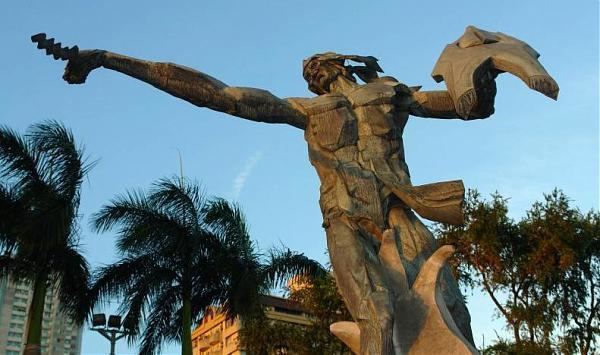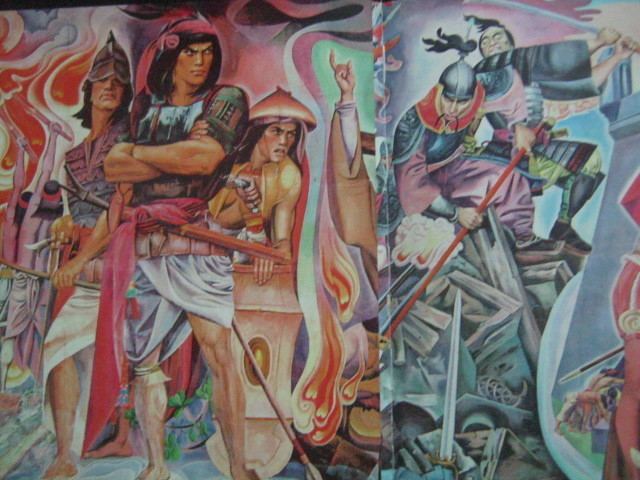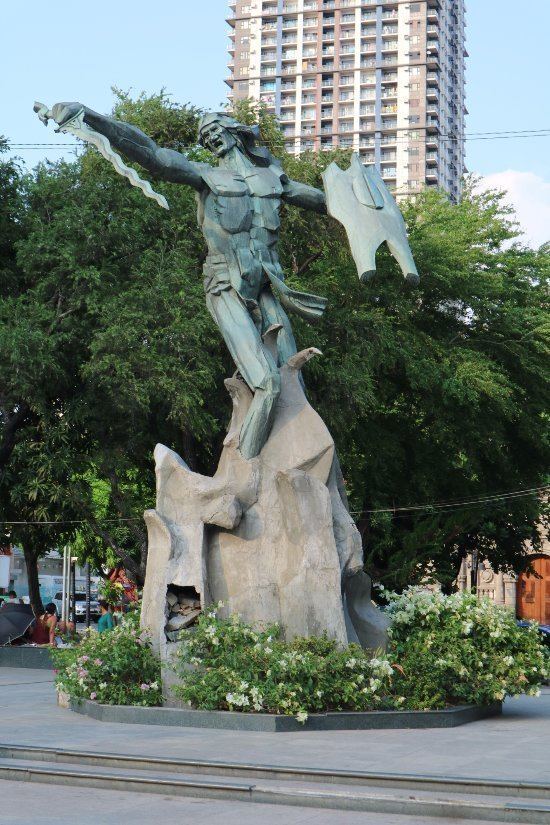Reign 1571–1575 Died 1575 Religion Sunni Islam | Name Rajah Sulayman Role Ruler | |
 | ||
House Kingdom of Namayan, Tondo and Sabag Similar Rajah Matanda, Lakandula, Magat Salamat Religion Islam | ||
hd liwasang rajah sulayman malate manila
Rajah Sulayman, sometimes referred to as Sulayman III (Sanskrit: स्ललैअह् , Baybayin: ᜐᜓᜎᜌ᜔ᜋᜈ᜔, Abecedario: Suláimán) (1558–1575), was the Rajah or paramount ruler of the Rajahnate of Maynila, a pre-Hispanic Moro vassal-kingdom of the Sultanate of Brunei at the mouth of the Pasig River in what is now Manila, Philippines. He also inherited rule of nearby Tondo and Namayan, becoming the first sovereign to hold all three realms in personal union.
Contents
- hd liwasang rajah sulayman malate manila
- Rajah Sulayman Wikipedia audio article
- Names
- Ancestry
- Spanish conquest of Manila 15701571
- Tarik Sulayman and the Battle of Bankusay 1571
- The Sulayman Revolt 1574
- Life after 1574
- Descendants
- Others
- Legacy
- References
He was the kingdom's penultimate indigenous ruler, as the state (along with Luzon and most of the archipelago), was gradually absorbed into the Spanish Empire beginning in the late 16th century. His eldest son, Bunao Dula, was crowned Lakan (paramount ruler) when Sulayman I was too sick to function as monarch. Sulayman I is the grandson of Abdul Bolkiah of the Sultanate of Brunei and the son of Sulayman Bolkiah. Sulayman l did not use the surname Bolkiah but instead used the official title of Rajah Soliman Dula l, to mark the new era of a united Manila aristocracy.

Sulayman resisted Spanish forces, and thus, along with Rajah Matanda and Lakan Dula, was one of three monarchs who defended and figured greatly in the Spanish conquest of the Port of Manila and the Pasig River delta in the early 1570s.

Rajah Sulayman | Wikipedia audio article
Names

Spanish documents note that Sulayman's subjects called him Raja Mura or Raja Muda (from the Sanskrit raja). The Spanish glossed this name as "Young Raja", a reference to the fact that he was Raja Matanda's nephew and heir apparent. The Spaniards also called him Raja Solimano el Mow.
Ancestry
According to the genealogy proposed by Mariano A. Henson in 1955, and asserted by Majul in 1973, Sulayman was the 14th Raja of Manila since it was founded as a Muslim principality in 1258 by Rajah Ahmad when he defeated the Majapahit Suzerain Raja Avirjirkaya.
Spanish conquest of Manila (1570–1571)
Rajah Sulayman was there when the invasion of Legazpi occurred. His predecessor asserted ancestry from Alexander the Great, Lakanduli, whose predecessor was Kanduli, whose predecessor was Rajah Nicoy who ruled the Muslim area in Manila before the Spanish invasion. It is believed that Islam would have disseminated all over the Philippines but for the Spanish invasion since both Luzon and Visayas saw the arrival of Islam. The Spanish conquest was fought against by Rajah Lakandula, Rajah Matanda, and their nephew Rajah Sulayman. Brunei's Sultan had familial ties with the Borneo originated royals who ruled Manila. Manila was converted by Muslims from Borneo. The war by Christians against Islam in the archipelago which terminated with the 1913 Bud Bagsak battle between Sulu and Americans began in 1571 when Martin de Goiti and Miguel Lopez de Legazpi and their subordinate army of Visayans, Latin-American soldiers and Spaniards attacked Rajah Sulayman's Manila Kingdom of Muslims and conquered it. Being part of its ancient trading ports and traditional ally, the Spanish experienced spectacular and catastrophic military assaults at the hands of the Muslim Moros from the Sama, Iranun, Maguindanaon and Suluk ethnicities after their conquest of Manila. This signal the start of the age old sovereign based conflict in the Archipelago. The royals and nobility of Brunei converted the royals of Manila to Islam and established familiar relations by matrimony which is why Rajah Sulayman was a known Muslim when the Spanish arrived. Julkipli M. Wadi wrote Rajah Sulayman, Spain and the transformation of the Islamic Manila. Miguel López de Legazpi, Juan de Salcedo, and Martín de Goiti led the invasion by the Spanish against Lakandula, Rajah Matanda and Maynila's final Muslim ruler, Rajah Sulayman III. Jose N. Svilla composed a Tagalog language Rajah Sulayman bio. A monument dedicated to Rajah Sulayman was erected by the inhabitants in memory of his resistance and martyrdom against the Spanish. Tondo ruled by Lakandula and Manila ruled by Sulayman were both Muslim since Luzon, Visayas, Mindanao and Sulu all experienced Islamic proselytization. Muslims were already all over the islands of the Philippines during the entry of the Spanish.
This area was a pre-colonial Indianized kingdom of Srivijaya and at their arrival has already shifted to Majapahit Empire. The Spanish explorer Miguel López de Legazpi, searching for a suitable place to establish his capital after moving from Cebu to Panay due to Portuguese claim of the archipelago, sent Martín de Goiti and Juan de Salcedo on an expedition northwards to Luzon upon hearing of a prosperous kingdom there.
Goiti anchored at Cavite and established his authority by sending a "message of friendship" to the states surrounding the Pasig River. Sulayman, who had been given authority over these settlements by the ageing Rajah Matanda, was willing to accept the "friendship" from the Spaniards. However, he refused to cede his sovereignty, and had no choice but to waged war against the new arrivals' demands. As a result, Goíti and his army invaded the kingdoms in June 1570, sacked and burned the great city before returning to Panay.
Tarik Sulayman and the Battle of Bankusay (1571)
Some controversy exists about the identity of the leader of the Macabebe people that initiated the Battle of Bankusay in 1571. That chieftain is referred to by Filipino historians as Tarik Sulayman. In some versions of the Battle of Bankusay, Tarik Sulayman of Macabebe and Sulayman III of Manila are the same person, while other contend that they are two separate individuals.
Spanish documents do not identify the leader of the Macabebe revolt by name, but record that he died during the 1571 Battle of Bankusay, resulting in a Macabebe retreat and Spanish victory. Sulayman III, on the other hand, is clearly recorded as participating in the Revolt of 1574, and thus cannot be the unnamed figure who died in 1571 at Bankusay.
The "Sulayman Revolt" (1574)
When López de Legazpi died in 1572, his successor, Governor-General Guido de Lavezaris, did not honour their agreements with Sulayman and Lakan Dula. He sequestered the properties of both kings and tolerated Spanish atrocities.
In response, Sulayman and Lakan Dula led a revolt in the villages of Navotas in 1574, taking advantage of the confusion brought about by the attacks of Chinese pirate Limahong. This is often referred to as the "Manila Revolt of 1574" but is sometimes referred to as the "Sulayman Revolt" and the "Lakan Dula Revolt." Since it involved naval forces, the Sulayman Revolt is also known as the "First Battle of Manila Bay".
Friar Geronimo Marín and Juan de Salcedo were tasked with pursuing conciliatory talks with the kingdoms. Lakan Dula and Sulayman agreed to Salcedo's peace treaty and an alliance was formed between the two groups.
Life after 1574
Some accounts from the American Colonial era claim that Sulayman was killed during the revolt of 1574, but this once again seems to be the result of Sulayman being confused with Tarik Sulayman of Macabebe, who had died in the previous revolt in 1571. A review of genealogical documents deposited at the Philippines' National Archives notes that Sulayman lived past the 1574 revolt, in which his son Rahang Bago was killed, and lived long enough to adopt the children of an unnamed sibling to be his descendants.
Sulayman is no longer mentioned in the accounts of events that took place from 1586 to 1588, which involved many members of his family.
Descendants
According to Luciano P.R. Santiago's genealogical research, Sulayman married his cousin, a princess from Borneo, and the two had at least two biological children: a son referred to as Rahang Bago (which means "new prince" Raxa el Vago in the Spanish texts), and a daughter who would be baptized Doña Maria Laran. A legend cited by the government of Pasay City in the 1950s also says Sulayman had two children: a son named Suwaboy, and a daughter, Dayang-dayang (Princess) Pasay, who would inherit from her father the lands south of Manila now known as Pasay and Paranaque. However, Rahang Bago and his cousin Lumantalan were killed by the Spanish in November 1574, in the confusion that ensued during the attack of the chinese Corsair Limahong.
According to Santiago's research, Doña Maria Laran had two daughters: Doña Ines Dahitim, the elder, who narrued Don Miguel Banal of Quiapo; and Doña Maria Guinyamat, who married a Don Agustin Turingan. Luciano P.R. Santiago theorizes that Don Miguel Banal was the son of the Don Juan Banal who was implicated in the Tondo Conspiracy of 1587. Santiago furthers that Don Miguel Banal and Doña Ines Dahitim are said to have begotten the second filipino to be inducted into the Augustinian order, Fray Marcelo Banal de San Agustin.
The oral legend cited by the local government of Pasay, in turn, says that Dayangdayang Pasay married a local prince named Maytubig and settled in the place called Balite. The legend says that they had a daughter named Dominga Custodio, who grew up to donate all her lands to the Augustinian Order just before her death.
Santiago, however, claims that aside from his biological children, Sulayman expanded his family through adoption, as indicated by Santiago's genealogical research. This research points to the existence of at least one male sibling of Sulayman, whose name does not appear in historical records and who predeceased Rahang Bago in 1574. Sulayman decided to adopt his sibling's sons, who are documented as Agustin de Legaspi, Don Gabriel Taumbasan, and Don Jeronimo Bassi. These three adoptees were involved in the Tondo Conspiracy of 1587. Of them, only Taumbasan avoided execution; he was instead sentenced to a four-year exile in Mexico.
Others
According to Meranau history
Legacy
In Rizal Park in Manila, the Philippines erected a statue to commemorate Rajah Sulayman as a hero against Spanish invasion.
